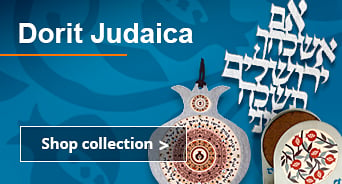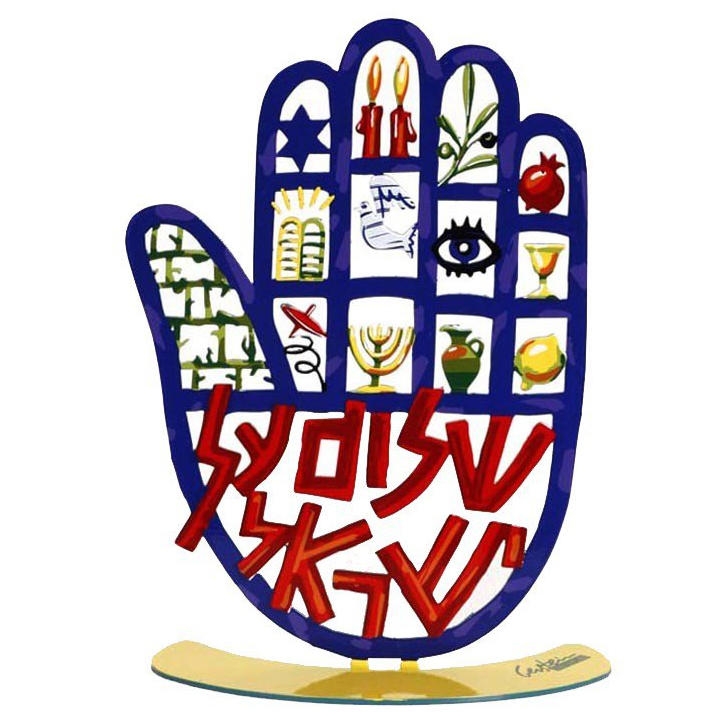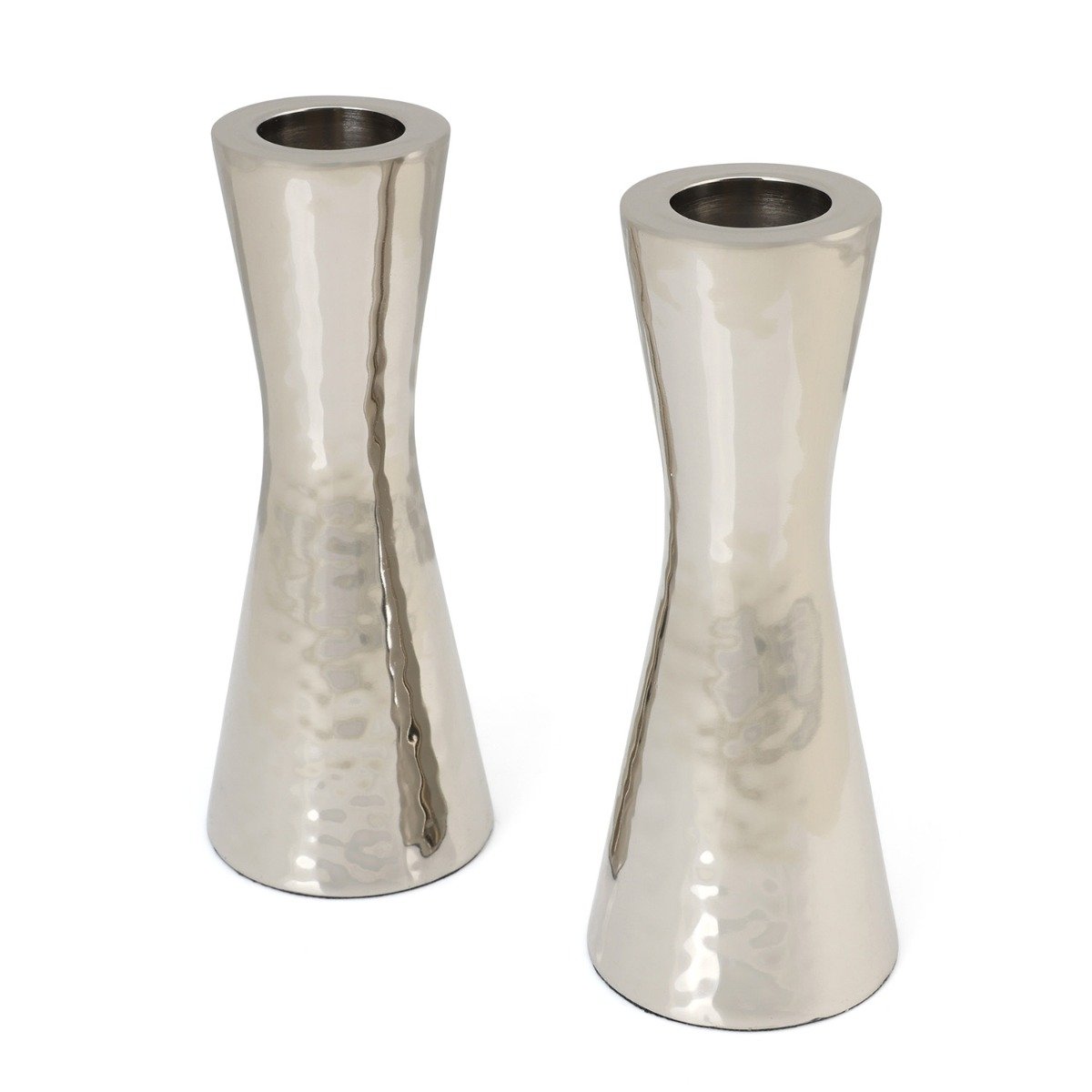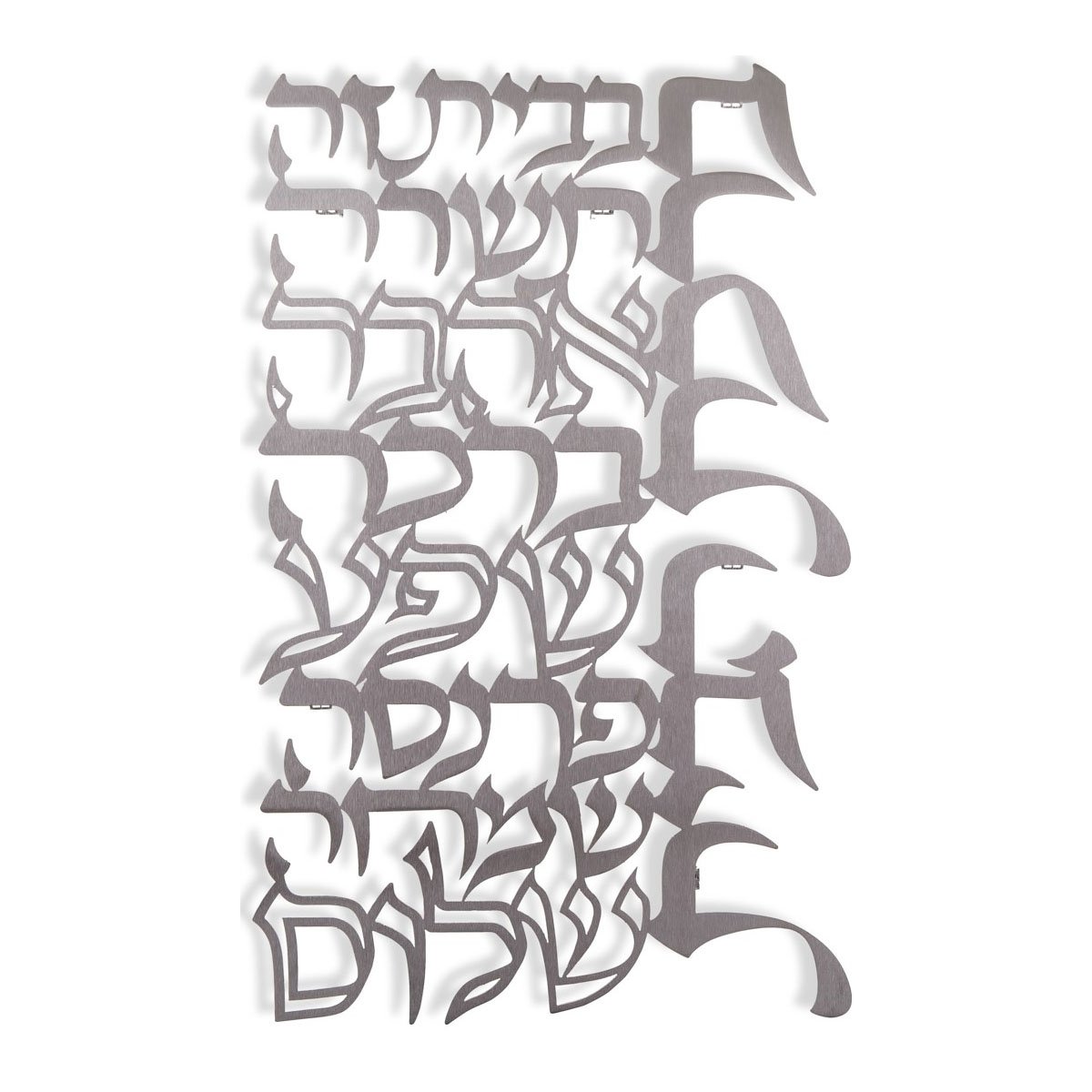
With five fingers that face palm-forward, the mysterious hand-shaped sign known as the Hamsa or Khamsa is believed to have originated centuries ago in the Middle-East, where its beauty and significance made the symbol one of the most prominent motifs of its age. Today, the Hamsa Hand is just as popular as ever, especially in Israel where many modern-day Jewish artists often use it for inspiration to create the finest Hamsa Art in the world! Each Hamsa from Israel will amaze you with its uniqueness and quality, so if you know people who would love to receive a gorgeous Israeli Hamsa, be sure to check out our exciting Hamsa collection to find the perfect one for the special person in your life!
Also, once you order yourself one or two, you’ll see that these traditional keepsakes are practically worth their weight in gold, so give something extra meaningful to your loved ones at the next special occasion or breathe new life into your home with spectacular Hamsa Hand Art! Between our exceptional product selection and our fast, almost-free shipping, sending incredible Israeli gifts worldwide is so easy, you’ll barely need to lift a finger to do it, so order something new from Israel today!
Hamsas: The Universal Symbol of Protection and What They Mean
Like countless antiquated cultures, ancient Jews were well-known for their love of symbols and images, which they used in everything from jewelry to architecture. Indeed, most early Jewish symbols such as the Evil Eye, Star of David, and the Tree of Life are still popular today; however, there's one distinctive emblem that may outdo the others in terms of history and meaning, and that would be the Hamsa symbol. Identified by multiple names across different cultures, the Hamsa hand sign is universally respected and adored, even by those who aren't sure what Hamsas are or who don't realize what the Hamsa Hand symbol means. Since it is a very old and complicated motif, if you're not familiar with it or have a question or two on how it's used, don't worry, you're not alone. Plenty of people ask things like: Which religion do Hamsas belong to? Should Hamsas be placed up or down? Or, Why wear a Hamsa? Each of these questions and more get answered below, so keep going if you want to discover real facts about the mysterious Hamsa Hand motif that is believed to be a powerful symbol of protection in places around the world!
What Religion Is the Hamsa Hand?
Let's start with a question that is constantly being asked: Which religion do Hamsas belong to?
Historically, Hamsas are thought to be predominantly Jewish as Judaism is credited with being the first religion to use them. However, due to how prominent the Hamsa symbol is in Judaism, Islam, and Christianity, perhaps a more realistic answer is that over time, the emblem has become multicultural, with every religion attributing its own cultural significance to the attention-grabbing image. Some historians even suggest that Hamsas predate each of these religions as many earlier Middle-Eastern civilizations were known to also have their own versions of hand-shaped symbols of protection, including the ancient Egyptians who had something similar to the Hamsa that was called the Mano Pantea or more simply, the Two Fingers.
Should the Hamsa Be Up or Down?
It makes little difference if the Hamsa is up or down as Hamsas can be worn either way, however, it is thought that when Hamsas face downwards, it increases the wearer's good fortune whereas when the fingers face upwards, it offers better protection against the Evil Eye.
Why Wear Hamsas?
Perhaps a better question is why not?! Seeing as they are stylish and meaningful, there's really no reason not to stay away from these beautiful creations.
Where to Place a Hamsa?
Anywhere you'd like! There's no limit on where you could put them, so have fun getting creative!
How Do Jews Look at Hamsas?
When it comes to Hamsas, Jewish culture associates a variety of meanings to the antiquated emblem. Some people hold the belief that the unique societal culture the Hamsa generates is that of superstition and outdated customs, whereas others feel that the Hamsa is a true ancient sign of protection, power, and strength that may help bring luck and positivity to one's life and home. Those who believe in the latter opinion are often the ones that continue to use the distinctive hand-shaped symbol in its main, time-honored form as an amulet for good luck and good fortune against the Evil Eye, however, there are plenty of individuals who enjoy using a Hamsa amulet purely for aesthetic reasons.
So What Is a Hamsa?
The main purpose of Hamsas is to protect against the Evil Eye. Hamsas are believed to have been initially introduced to the Middle-East by early Middle-Eastern Jewry, who may have used the open-palm emblem fist as a means of protection against the Evil Eye, then later as a source of good luck.
How Do Hamsas Prevent The Evil Eye?
According to Jewish tradition, the powerful, malignant energy recognized as the Evil Eye resulted when someone looked at another person with jealousy, spite, or a desire for that person's downfall. The malicious spirit was thought to be a primary cause of illnesses, harm, and injury, and the belief was common at the time as people were more superstitious than their modern-day counterparts. As it became necessary for these communities to find new, creative ways to protect themselves, they began to search for something that could shield them from the attention of anyone who might wish to 'curse' them with their bad intentions.
Luckily, they didn't have to search long because Hamsas became the new, surefire way a person could block this invisible, destructive force! As more people from Mid-Eastern Jewish communities welcomed the new, intriguing design as a protective talisman against the Evil Eye, the popularity of Hamsas surged around the region until eventually, Hamsas became one of the most iconic and universally loved emblems to ever exist.
What Inspired the Hamsa Design?
It is unknown what precisely inspired Jews to start using the emblem of a hand as a protective motif, but it is thought that a passage in the Bible may have had something to do with it. While no mention of either Hamsas or the Evil Eye can be found in any of the five books of the Torah, historians nevertheless assume that the Hamsa Hand motif is based on the biblical expression, the "Hand of God." This verse, which is found in the Book of Devarim (Deuteronomy), states that a "strong Hand of God" led the Jews from Egypt, demonstrating that only God had the ability to set them free from the bondage of slavery. For this reason, it is speculated that when Jewish men and women wanted something to symbolized the protective power and strength of God, they adopted the Hamsa Hand to shield them from disaster and misfortune the way the Hand of God shielded Israel in the Bible. Additionally, it is thought that a Hamsa's five fingers represent the five senses a person should remember to use to praise God. As a result, Hamsas ultimately became very influential, highly regarded, and were even considered holy at certain points in history because of their indirect connection to God.
Hamsas in Other Cultures
Aside from Jews, other cultures are known to share a deep connection to this famous hand emblem and each has its own interpretation of the Hamsa hand meaning and its usage. Depending on whether the observer is Jewish, Christian, or Muslim, the emblem has been called the Hand of Miriam, the Hand of Mary, or the Hand of Fatima. All three religions, however, revere it as a sign of protection.
In Islam
For Muslims, Hamsas are said to represent the Five Pillars of Islam, with each finger of the hand symbolizing one of the five keystones of the faith. Islamic tradition also associates the number five with resisting the Evil Eye, although Maghrebi Jews are likewise known to associate the number five with Hamsas, though for different purposes. In Arabic, the word Hamsa is often spelled as "Khamsa," and both spellings of the word Hamsa means 'five,' a name that is obviously derived from the five fingers of the Hamsa hand, though the word can also be literally translated as 'the five fingers of the hand.'
What Is the Symbol of a Hand With An Eye?
An interesting fact about Hamsas is that in certain Arabic countries, when the Khamsa features an eye in the center, it might be referred to as the Hand of Fatima, named in honor of Mohammad's daughter Fatima, an iconic Islamic female figure. The reason why Muslims link Fatima to this symbol is that in Islam, Hamsas are commonly connected with women, and most feel that the Hand of Fatima represents feminity. Jews sometimes have a similar view, though they prefer to call the symbol the Hand of Miriam after Moshe's (Moses') sister, though it's rare to hear anyone call it the Hand of Miriam as this moniker is not as well-known as most other name variants. That said, as both religions similarly associate the hand-shaped emblem with prominent female figures, it has led the symbol to also be called the Holy Hand of Women.
In Christianity
As for Christianity's view of Hamsas, they also recognize the emblem as a talisman of protection and a bringer of good fortune, though the symbol is less popular with them as it is in Judaism and Islam.
Still have unanswered questions about the Hamsa symbol?
Not a problem! Just send us an email with your name, email address, and question and our team of professionals will be more than happy to help you search for answers and email you back! In the meantime, don't forget to take advantage of our almost free-shipping to get yourself new and stunning Hamsas from Israel's best artists!












